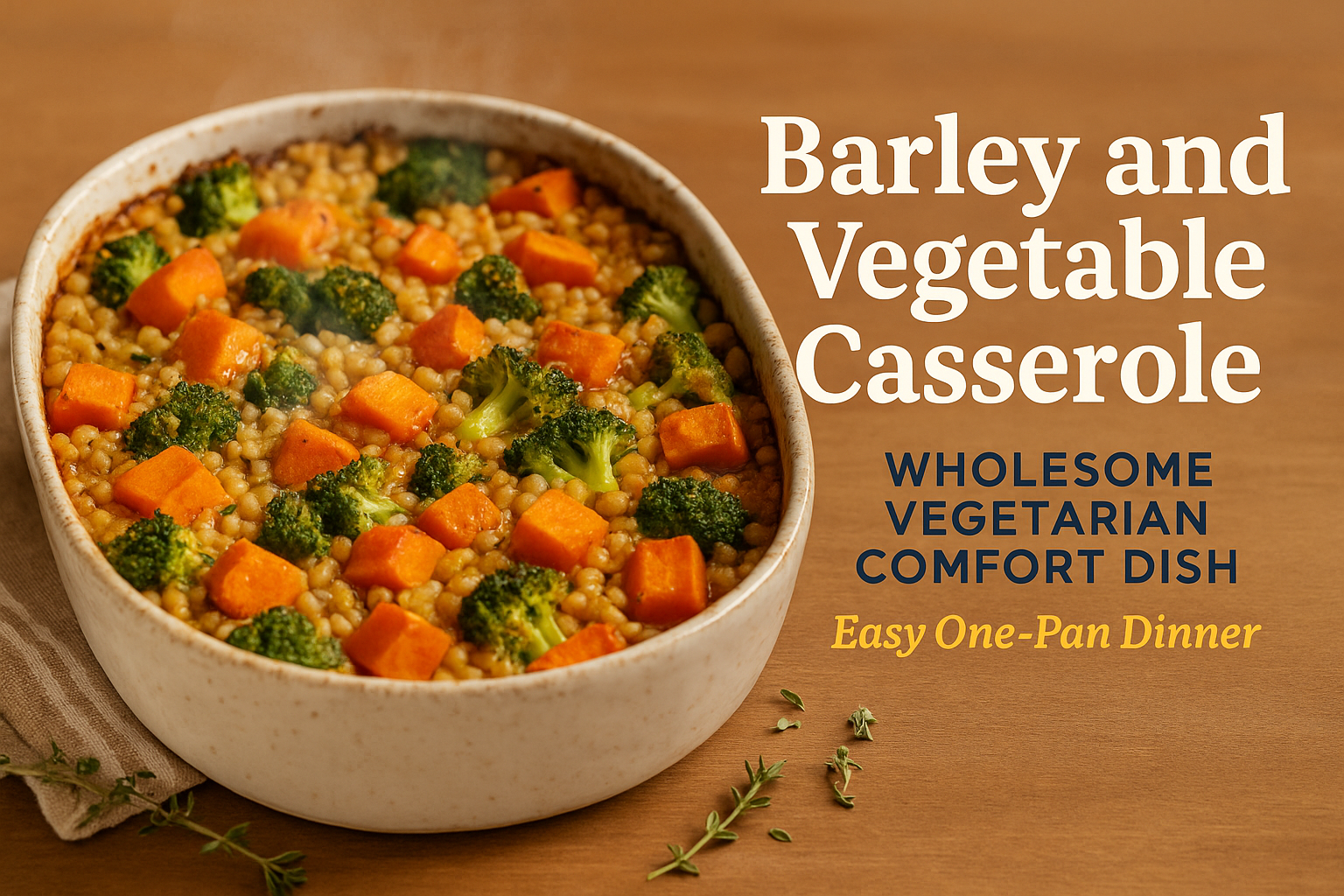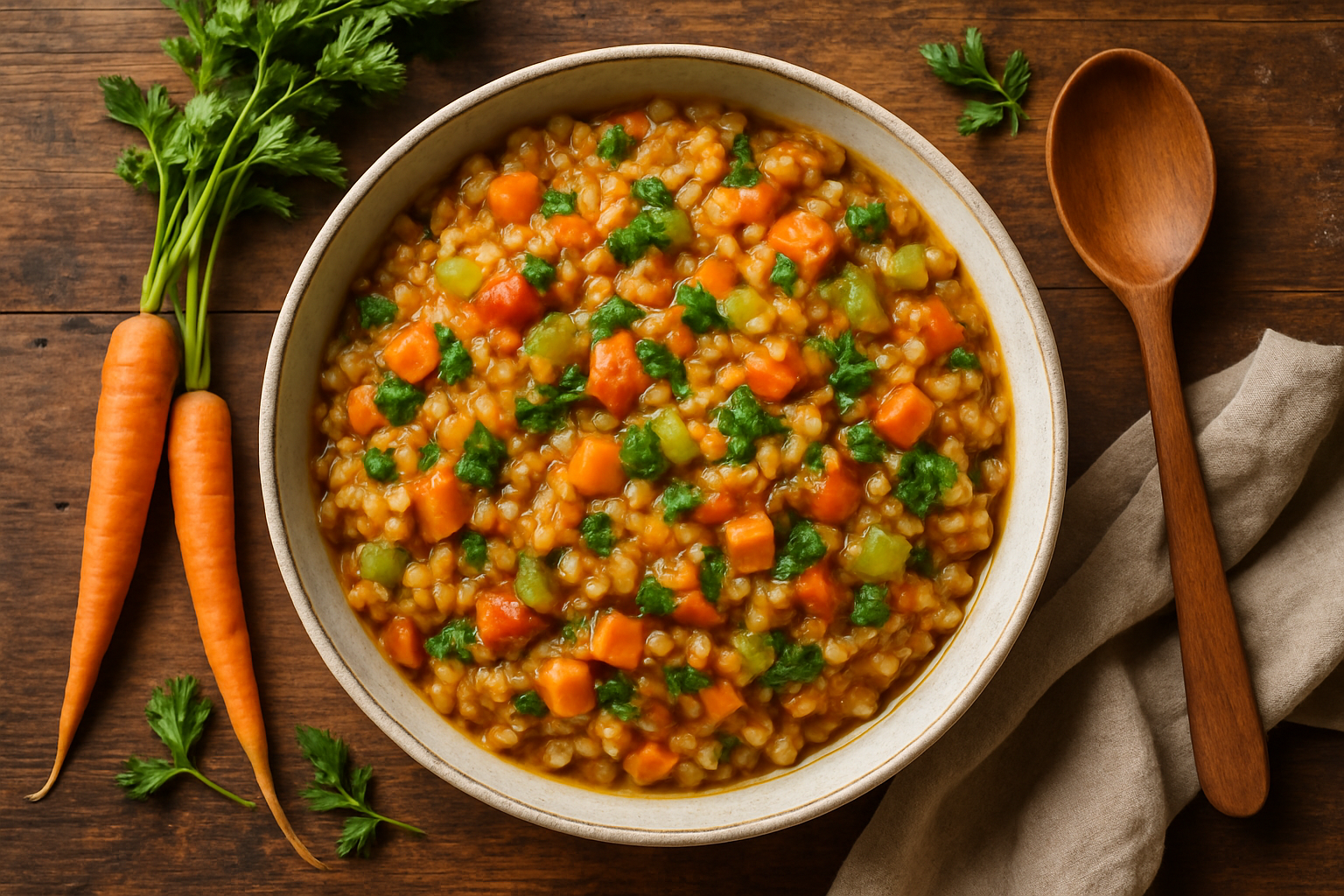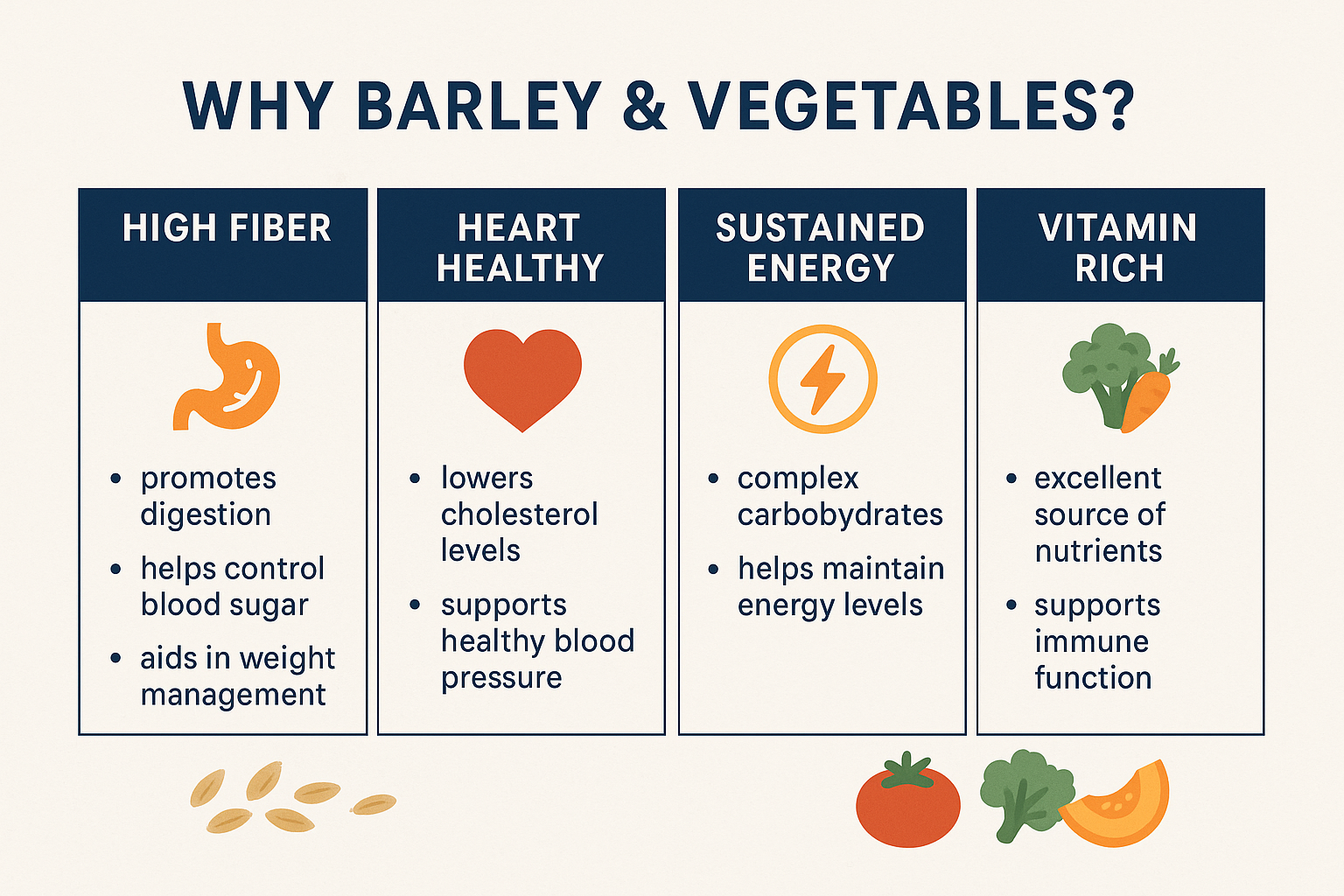Barley and Vegetable Casserole – A Wholesome Vegetarian Comfort Dish
Picture this: it’s a chilly evening in 2025, and you’re craving something warm, nourishing, and satisfying that doesn’t require hours in the kitchen or a mountain of dishes. Enter the barley and vegetable casserole—a one-pan wonder that transforms humble ingredients into a restaurant-worthy meal that’ll have everyone asking for seconds. This isn’t just another vegetarian recipe; it’s a complete nutritional powerhouse that proves comfort food can be both wholesome and utterly delicious. Whether you’re a seasoned plant-based eater or simply looking to incorporate more vegetables into your weekly rotation, this hearty casserole delivers on flavor, nutrition, and convenience.
Key Takeaways

What Makes Barley and Vegetable Casserole So Special?
In a world obsessed with complex recipes and exotic ingredients, there’s something refreshingly honest about a dish that celebrates simplicity. Barley and vegetable casserole stands out because it masterfully balances nutrition, flavor, and convenience without compromising on any front.
The Nutritional Powerhouse
Barley often gets overlooked in favor of trendy grains like quinoa or farro, but this ancient grain deserves serious recognition. Pearl barley and hulled barley both offer impressive nutritional profiles:
| Nutrient | Amount per 1 cup cooked barley | % Daily Value |
|———-|——————————-|—————|
| Fiber | 6g | 24% |
| Protein | 3.5g | 7% |
| Selenium | 13.5 mcg | 24% |
| Copper | 0.2 mg | 18% |
| Manganese | 0.4 mg | 17% |
| Vitamin B3 (Niacin) | 3.2 mg | 20% |
When combined with a rainbow of vegetables, this casserole becomes a complete nutritional package. Each vegetable contributes its own unique vitamins, minerals, and phytonutrients—from the beta-carotene in carrots to the vitamin K in leafy greens.
The One-Pan Magic ✨
Let’s be honest: nobody wants to spend their evening washing a sink full of dishes. The beauty of this casserole lies in its one-pan simplicity. Everything goes into a single baking dish, gets popped in the oven, and emerges as a cohesive, flavorful meal. This approach isn’t just convenient—it also allows the flavors to meld together beautifully as the ingredients cook in harmony.
Essential Ingredients for the Perfect Barley Vegetable Casserole
Creating an outstanding casserole starts with quality ingredients. Here’s what you’ll need to build your foundation:
The Base: Choosing Your Barley
Pearl barley is the most common variety found in supermarkets. It’s been polished to remove the outer hull and bran layer, which makes it cook faster (about 45-50 minutes) and gives it a slightly softer texture. Hulled barley (also called whole grain barley) retains more of its nutritional value but requires longer cooking time (60-90 minutes).
For this casserole, pearl barley works beautifully because it cooks evenly with the vegetables and absorbs flavors wonderfully.
The Star Players: Vegetables 🥕🥦🧅
The vegetable selection is where you can truly personalize this dish. Here are the best options:
Root Vegetables:
Cruciferous Champions:
Aromatics:
Leafy Additions:
Flavor Builders
Don’t underestimate the power of herbs, spices, and liquids:
Step-by-Step Guide to Creating Your Casserole
Preparation Phase (15 minutes)
1. Preheat and Prep
Set your oven to 375°F (190°C). This moderate temperature ensures even cooking without drying out the vegetables or barley.
2. Rinse Your Barley
Place 1½ cups of pearl barley in a fine-mesh strainer and rinse under cold water for about 30 seconds. This removes excess starch and prevents clumping.
3. Chop Your Vegetables
Aim for uniform pieces (roughly ¾-inch cubes) so everything cooks evenly. This is crucial for achieving that perfect texture where nothing is mushy or undercooked.
Assembly Phase (5 minutes)
4. Layer Your Ingredients
In a large 9×13-inch baking dish or Dutch oven:
5. Add Liquids
Pour in 4 cups of hot vegetable broth. The liquid should just cover the ingredients. Add:
6. Stir and Cover
Give everything a gentle stir to distribute seasonings. Cover tightly with aluminum foil or a lid—this traps steam and ensures even cooking.
Baking Phase (50-60 minutes)
7. Initial Bake
Place in the preheated oven for 45 minutes without peeking. Resist the temptation to check—you want to keep all that steam inside!
8. Check and Adjust
After 45 minutes, carefully remove the foil and check the barley. It should be tender but still have a slight chew. If it’s too firm, add ½ cup more hot broth, re-cover, and bake for another 10-15 minutes.
9. Final Touch
For a golden top, remove the foil for the last 10 minutes of baking. You can also sprinkle breadcrumbs mixed with olive oil for added texture.
Finishing Touches
10. Rest and Garnish
Let the casserole rest for 5-10 minutes after removing from the oven. This allows the liquids to redistribute. Finish with:
Creative Variations to Keep Things Interesting
Mediterranean Style 🌿
Transform your casserole with Mediterranean flavors:
Mexican-Inspired Fiesta 🌶️
Give your casserole a southwestern twist:
Asian Fusion
Create an umami-rich version:
Harvest Season Comfort
Celebrate fall flavors:
The Health Benefits: Why This Dish Deserves a Spot in Your Rotation

Digestive Health Champion
The high fiber content in both barley and vegetables supports digestive health in multiple ways:
Heart Health Hero ❤️
This casserole is a cardiovascular superstar:
Energy and Vitality
Unlike refined grains, barley provides sustained energy release:
Immune System Support
The diverse array of vegetables creates a nutrient-dense meal:
Meal Prep and Storage Tips for Maximum Convenience
Batch Cooking Strategy
This casserole is meal prep perfection:
Make Ahead:
Freeze for Later:
Storage Guidelines
Refrigerator:
Freezer:
Serving Suggestions and Pairings
Complete the Meal
While this casserole is satisfying on its own, these additions create a complete dining experience:
Protein Boosters:
Fresh Contrasts:
Bread Companions:
Troubleshooting Common Issues
Problem: Barley is Too Firm
Solution: The barley needs more liquid or cooking time. Add ½ cup hot broth, cover, and bake for another 10-15 minutes. Remember that hulled barley takes significantly longer than pearl barley.
Problem: Casserole is Too Watery
Solution: Remove the foil and bake for an additional 10-15 minutes to allow excess liquid to evaporate. Next time, reduce the broth by ½ cup or add more vegetables to absorb the liquid.
Problem: Vegetables are Mushy
Solution: The vegetables were cut too small or the casserole was overbaked. Aim for ¾-inch pieces and check for doneness at 45 minutes. Delicate vegetables like zucchini should be added in the last 20 minutes of cooking.
Problem: Bland Flavor
Solution: This usually means insufficient seasoning. Don’t be shy with salt—it’s essential for bringing out the natural flavors of vegetables. Also ensure you’re using flavorful vegetable broth rather than just water. Add finishing touches like fresh herbs, lemon juice, or a drizzle of good olive oil.
Problem: Top is Burning
Solution: Your oven may run hot, or the casserole is positioned too close to the heating element. Move to a lower rack and reduce temperature by 25°F. Keep covered for more of the cooking time.
Building Upper Body Strength: The Connection to Wholesome Eating
While it might seem unrelated, proper nutrition directly impacts your fitness results. If you’re incorporating arm toning workouts or dumbbell shoulder exercises into your routine, meals like this barley and vegetable casserole provide the fuel your body needs to build and maintain upper body strength.
The Fitness-Nutrition Connection
Complex carbohydrates from barley replenish glycogen stores depleted during strength training, while the protein content supports muscle recovery. The anti-inflammatory properties of vegetables help reduce exercise-induced inflammation, speeding up recovery time between workouts.
Minerals like magnesium and potassium found abundantly in this dish help prevent muscle cramps and support proper muscle contraction—essential for those challenging shoulder presses and bicep curls. The B vitamins facilitate energy production, ensuring you have the stamina for your complete upper body strength routine.
Budget-Friendly Comfort Without Compromise

In 2025, with grocery prices continuing to fluctuate, finding nutritious meals that don’t break the bank is more important than ever. This casserole checks all the boxes:
Cost Analysis
Affordable Ingredients:
Cost Per Serving:
When making a full casserole (8-10 servings), the cost typically ranges from $1.50-$2.50 per serving—significantly less than takeout or pre-packaged meals, and far more nutritious.
Money-Saving Tips 💰
Environmental Benefits of Plant-Based Casseroles
Choosing vegetable-forward meals like this casserole isn’t just good for your health—it’s beneficial for the planet:
Lower Carbon Footprint
Plant-based meals generate significantly fewer greenhouse gas emissions compared to meat-centered dishes. Barley requires less water and land to produce than animal proteins, making it an environmentally responsible choice.
Reduced Food Waste
This casserole is perfect for using up vegetables that are past their prime but still perfectly edible. Those slightly wilted greens, the lonely carrots in the crisper drawer, and that half-used bunch of celery all find a delicious home in this dish.
Seasonal Eating
By adapting the recipe to use seasonal vegetables, you’re supporting local agriculture, reducing transportation emissions, and enjoying produce at peak flavor and nutrition.
Making It Kid-Friendly
Getting children to embrace vegetable-rich meals can be challenging, but this casserole has several advantages:
Kid-Approved Strategies
Hide the Vegetables: Chop vegetables smaller and mix them thoroughly with the barley so they’re less obvious to picky eaters.
Let Them Help: Children are more likely to eat what they help prepare. Let them wash vegetables, stir ingredients, or choose which vegetables to include.
Cheese It Up: A layer of melted cheese on top can make any casserole more appealing to young eaters.
Serve with Favorites: Pair the casserole with a familiar favorite side dish to ease the transition.
Make It Fun: Use cookie cutters to cut vegetables into fun shapes before adding to the casserole, or create a “rainbow” theme by highlighting all the different colors.
Adapting for Dietary Restrictions
Gluten-Free Option
While barley contains gluten, you can easily substitute with certified gluten-free grains:
Vegan Confirmation ✅
This recipe is naturally vegan when you:
Low-Sodium Version
For those watching sodium intake:
Oil-Free Adaptation
For a whole-food plant-based approach:
The Science of Flavor Development in Casseroles
Understanding what happens during the baking process helps you become a better cook:
Maillard Reaction
When you remove the foil for the final bake, the Maillard reaction occurs—a chemical reaction between amino acids and sugars that creates complex, savory flavors and appealing golden-brown color on the surface.
Flavor Concentration
As the casserole bakes, liquid evaporates, concentrating the flavors. This is why the seasoning should be slightly under what you’d use for a stovetop dish—the flavors intensify as it cooks.
Vegetable Caramelization
The natural sugars in vegetables caramelize during baking, developing sweetness and depth. This is especially noticeable with root vegetables like carrots and sweet potatoes.
Aromatics Infusion
Whole garlic cloves, bay leaves, and fresh herb sprigs infuse their flavors throughout the dish as they cook, creating layers of taste that develop over time.
Seasonal Variations Throughout the Year

Spring Casserole 🌸
Celebrate fresh spring produce:
Summer Bounty ☀️
Take advantage of summer vegetables:
Autumn Harvest 🍂
Embrace fall flavors:
Winter Warmth ❄️
Stick to hearty, storage-stable vegetables:
Expert Tips for Casserole Success
From Professional Chefs
Toast Your Barley: Before adding to the casserole, toast the rinsed barley in a dry skillet for 3-4 minutes. This adds a nutty depth of flavor.
Layer Strategically: Place harder vegetables (carrots, potatoes) on the bottom where they’ll get more heat, and delicate ones (zucchini, leafy greens) on top.
Use Hot Liquid: Adding hot vegetable broth instead of cold jumpstarts the cooking process and ensures more even results.
Don’t Skip the Rest: Allowing the casserole to rest after baking lets the starches set up, making it easier to serve and improving texture.
Finish with Acid: A squeeze of lemon juice or splash of vinegar just before serving brightens all the flavors and makes the dish taste more complex.
Leftover Transformation Ideas
Day-Two Delights
Casserole Cakes: Form cold leftover casserole into patties, coat with breadcrumbs, and pan-fry until crispy on both sides.
Stuffed Peppers: Use the casserole as filling for bell peppers, top with cheese, and bake until peppers are tender.
Soup Base: Add extra broth and blend partially for a hearty, textured soup.
Breakfast Bowl: Top with a fried egg and hot sauce for a satisfying breakfast.
Wrap Filling: Stuff into a whole wheat tortilla with hummus and fresh greens for a portable lunch.
The Social Aspect: Perfect for Gatherings
This casserole shines at potlucks, family dinners, and meal trains:
Why It’s Party-Perfect
Feeds a Crowd: Easily doubles or triples for large gatherings
Transport-Friendly: Travels well when kept covered
Temperature Flexible: Tastes great hot, warm, or even at room temperature
Dietary Inclusive: Accommodates vegetarians, vegans, and those reducing meat intake
Make-Ahead Friendly: Can be assembled the day before and baked when needed
Conclusion: Your New Go-To Comfort Meal
The barley and vegetable casserole represents everything we should want from our weeknight dinners in 2025: it’s nourishing, convenient, budget-friendly, environmentally conscious, and absolutely delicious. This isn’t a recipe that requires exotic ingredients or advanced culinary skills—it’s honest, wholesome food that celebrates the natural flavors of quality vegetables and whole grains.
Whether you’re meal prepping for a busy week, feeding a family, recovering from your latest arm toning workout, or simply craving comfort food that makes you feel good, this casserole delivers. The beauty lies in its flexibility—make it your own by swapping vegetables based on what’s in season, what’s on sale, or what’s hiding in your crisper drawer.
Your Action Plan
Ready to make this casserole part of your regular rotation? Here’s what to do next:
The journey to eating more vegetables and whole grains doesn’t have to be complicated or boring. Sometimes the most satisfying meals are the simplest ones—where quality ingredients, proper technique, and a little patience create something truly special.
So preheat that oven, gather your vegetables, and get ready to fall in love with a casserole that proves vegetarian comfort food can be every bit as satisfying as its meat-based counterparts. Your body, your wallet, and your taste buds will thank you. 🥘✨
—
SEO Meta Information
Meta Title: Barley Vegetable Casserole Recipe – Easy One-Pan Dinner 2025
Meta Description: Discover the ultimate barley and vegetable casserole recipe! This wholesome one-pan vegetarian dinner is packed with nutrients, budget-friendly, and perfect for meal prep.
—




